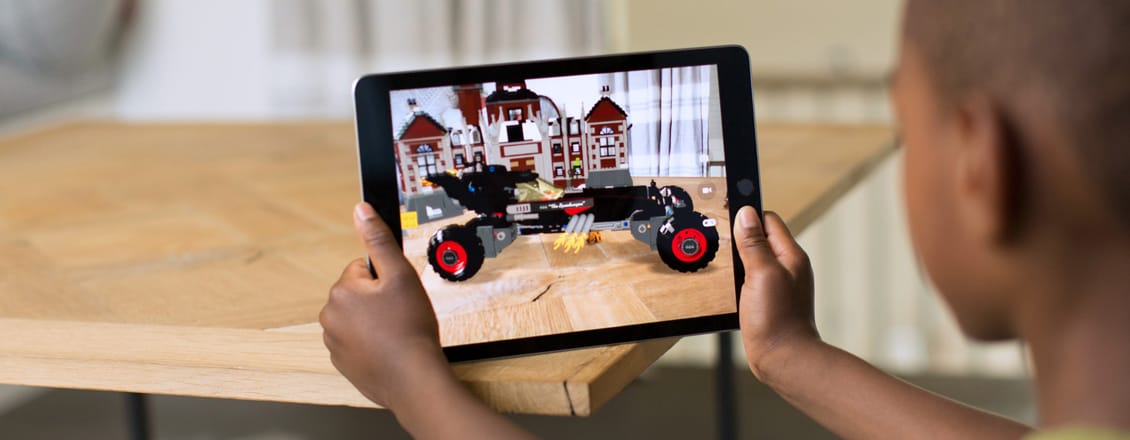
Apple ARKit
What is ARKit?
The ARKit is Apple’s new technology solution for AR Applications. ARKit was annonced by Apple at the WWDC in 2017 and published as new part of the iOS 11 for recent iPhones and iPads. Up until that, developers had access of a new Beta Version of iOS 11 and ARKit and were able to create demo applications. “Finding horizontal surfaces like the floor or a table surface“, “placement of virtual objects in real size” and “creating lighting of virtual objects based on real environment light conditions” are some of the new features.
Announcement of ARKit (WWDC 2017)
Wingnut AR Demo
ARKit was announced by Apple at the WWDC 2017 as future part of iOS (coming pu: autumn 2017 with iOS 11) and introduced on the basis of some demos. The video shows an ARKit Demo with Unreal-Engine presented as a AR game.
Applications / Demos with ARKit of various developers
ARKit Demo by Laan Labs
AR Measure App
Measuring of rooms made easy! The ARKit, as the first basic technology ever, offers an “out of the box” solution in order to scale sizes of virtual additions (e.g. 3D models) in relation to the real environment (without needing tracking markers, depth sensors or two front cameras). The project “tape measure” (ARMeasure.com) shows how accurately the size relation can be matched and the virtual tape measure used compared to a real one.
ARKit Demo by StoryToys
My Very Hungry Caterpillar AR
What was of high interest in 2016 with “Pokémon Go”, will now be even more convincing due to the robust floor recognition of ARKit and the well-known strength of AR technology. The ARKit Demo App “My Very Hungry Caterpillar” shows in a short video how one can play and interact with pets as a part of reality in the future. This is how famous characters of books, movies, video games and other media can become our companions and make every day an exiting adventure.
ARKit Demo by Biborg
Mix Realities with ARKit
The video of the ARKit Demo “ARKit Portal” of the French company Biborg shows that the three fundamental bases of ARKit can lead to new ways of application in a very creative way. Floor recognition and the SLAM technology are combined toghether with technically optimized 3D contents and used as tools to navigate in the superimposed scene. The user can very easily switch between the real environment and the virtual room. Virtual building drafts (Videolink) and far away places (have to be digitalized before) can be discovered with the same principle.
ARKit Demo by Jelmer Verhoog
AR Configurator Tesla Model 3
Due to the robust floor recognition of ARKit, lager objects can be steadily integrated into the camera picture. The demo of the vehicle configurator of J. Verhoog shows some basic functions (controlling the lights, choosing the vehicle color) and even allows the user to control the car via smartphone. In an extended version, rims can be changed, the interior individually designed and even a direct connection to car dealerships made.
How does ARKit work?
ARKit uses sensors (Camera, 6D sensors for rotation, position and acceleration sensors) as a basis for Visual Inertial Odometry (VIO). Incoming data of the camera will be analysed together with the data of Gyroscope (Position and Rotation) and the acceleration sensor. It will be then compared to each other and therefore enables tracking of translation and orientation of the smart device in a room with a high precision. That is how virtual overlapping in the context of the room and the camera’s perspective can be displayed. At the same time, size relations between reality and virtual additions can be matched very precisely. The analysis of the camera stream and light sensor data will furthermore be used to analyse real lighting conditions in order to adapt the virtual lighting accordingly.
What are advantages of ARKit compared to other AR Technologies?
Compared to other technologies of third-party providers (vuforia, Wikitude, etc.), the Apple ARKit is a regular feature of the mobile opperating system iOS 11, which will be running on approximately 500 million iPhones and iPads in 2017. For the first time has a robust and widely spread AR SDK been found. Almost over night, Apple abolished one of the two remaining obstacles for the AR market building. Native apps, but also apps of third-party providers, have now access to native AR functions. As a reliable and long-term provider of AR technologies, Apple, together with ARKit developers, offers a steady basis for AR Apps.
What are the disadvantages of ARKit compared to other AR Technologies?
Compared to established AR technologies that are independent from platforms, like vuforia or wikitude, the ARKit is part of iOS and can therefore only be used on devices with the corresponding operating system (iPhone, iPad, etc.). If an application based on ARKit is to be realized as a cross platform solution and therefore able to be used on Google’s operating system Android, Google’s new AR solution ARCore (get more information at ARCore in the Spotlight) could be used as a counterpart to the ARKit. Even though ARKit and ARCore, and therefore Apple and Google, strive for the same goals, it has to be tested in each case, if every function of a new AR app can be realized on both platforms.

